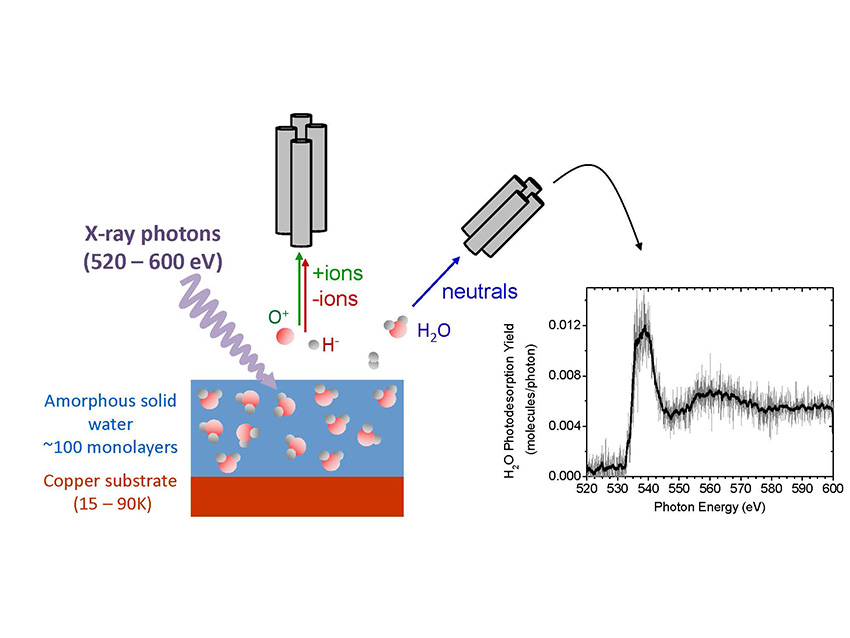In cold and dense regions of the interstellar medium, numerous molecules are observed. Some move freely in the gas phase, others are frozen at the surface of tiny dust grains, forming so-called ice mantles. When the grains are cold enough, molecules forming at their surface or accreting on them should stick. This is in contradiction with observations of the gas of cold regions made by astronomers. A team from the Laboratoire d’Etudes du Rayonnement et de la Matière en Astrophysique et Atmosphères (Sorbonne Université & Observatoire de Paris), on collaboration with researchers from the Laboratoire de Chimie Physique (Université Paris-Sud), CERN, and the Laboratori Nazionali di Frascati, experimentally investigated the efficiency of one process, photodesorption (ejection of molecules by photons) by X-rays. This process had not been considered so far in astrochemical models of X-ray irradiated regions of the interstellar medium.
The SEXTANTS beamline in SOLEIL provided the X-ray light necessary to this study, published in Nature Astronomy journal.
Processes allowing to get molecules off the ice mantles to the gas phase must exist. They imply bringing energy to the molecules, in the form of radiation (UV, X-rays, cosmic rays), chemical energy, shocks…
UV light is ubiquitous to the interstellar medium. This is why the process by which a UV photon detaches a molecule from an ice mantle (photodesorption) has been taken into account in astrochemical models and studied in detail in the laboratory. However, there are regions of the interstellar medium irradiated also by X-rays, such as protoplanetary disks where the young star has a strong emission in this energy range. Laboratory studies are crucial to model the physics and chemistry of these objects. However, no quantitative determination of the photodesorption has been made in the soft X-ray range and the physical mechanisms at play have yet to be elucidated.
This is what this study did in the case of water ice. The authors used the ultra-high vacuum experimental chamber SPICES 2, which is dedicated to the study of processes at the interface between solid phase and gas phase at low temperature. The chamber was brought to the SEXTANTS beamline of the SOLEIL synchrotron. The ultra-high vacuum is necessary to study surface phenomena, and the low temperature (15 K) reproduces that of the studied regions of space. The SEXTANTS beamline brings intense X-ray light, crucial to obtaining a good signal, but also monochromatic light, which allows to study the wavelength dependence of photodesorption and extrapolate to the spectra of the various regions of the interstellar medium that can be relevant.
The results are a quantification of the photodesorption of the water molecule, but also of other neutral or ionized species deriving from the fragmentation and photochemistry induced by the X-rays in the water ice. Previous studies had mostly considered the H+ ion, but the photodesorption of neutral species turned out to be much higher. The obtained numbers can be used in astrochemical models of regions like protoplanetary disks, allowing to assess what impact the X-ray photodesorption process can have on the physics and chemistry of these environments.

Schematics of the experiment. A layer of water ice with a thickness of about 100 molecules is deposited on a cold substrate and irradiated with synchrotron radiation, scanning the photon energy (in electron-volt). The various ejected species are detected by mass spectrometry. On the right is an example of obtained result: the photodesorption yield of the neutral water molecule as a function of photon energy.
This work benefited from the SOLEIL synchrotron facility at the SEXTANTS beamline (project 20161406).This work was supported financially by the Programme National “Physique et Chimie du Milieu Interstellaire” (PCMI) of CNRS/INSU with INC/INP co-funded by CEA and CNES, by the LabEx MiChem and the DIM ACAV Région Ile-de-France program, and the European Organization for Nuclear Research (CERN, KE3324/TE).
